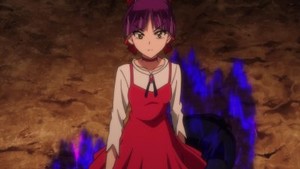GeGeGe no Kitarō
Episodes 27-28
by Rebecca Silverman,
How would you rate episode 27 of
GeGeGe no Kitarō (TV 2018) ?
Community score: 3.7
How would you rate episode 28 of
GeGeGe no Kitarō (TV 2018) ?
Community score: 3.6

These are two of GeGeGe no Kitarō's most violent episodes, and while they're not quite as disturbing as some of the earlier ones, they definitely have their moments. They also begin the series' first multi-episode arc, one dealing with Western yokai coming to Japan after Agnes, a young witch, tries to stop their evil plans by escaping with the Ring of the Arcana, a powerful artifact.
Thematically, these episodes deal with the idea of invasions and refugees, and this is actually a good way to help make those issues known to younger viewers. Before Agnes arrives in the GeGeGe no Mori, Kitaro and his friends welcome in a group of foreign yokai whose land was destroyed by some unknown yet terrifying force. (We later learn that they're Malay hantu.) Kitaro tries his best to welcome them in, despite a token resistance from Rat Man, but problems soon arise as the Malay group has trouble adapting to their new home – and the Japanese group has equal trouble understanding that yokai from different places might have different habits and customs. The fact that Malay spirits are generally a bit more destructive and malicious than some of the Japanese ones probably factors into this – I suspect that the one they call Biddy in episode twenty-six is actually Hantu Balung Bidai, an evil water ghost known to drown people. In any event, the two groups are unable to find peaceful coexistence, which leads to Kitaro basically granting the hantu territory, to nobody's satisfaction.
What's interesting about this is the way that the theme of not getting along with those different from you comes back in episode twenty-seven in a slightly different way. Yes, the Western yokai, led by the hilariously named Backbeard, are trying to get back what Agnes stole from them, but Agnes herself seems to have little regard for the way the Japanese yokai do things. She's on a mission to save the world, true, but her disregard for Kitaro and Cat Girl trying to find her a place to live and then her later casting of a spell on Kitaro in an effort to force him to destroy the ring show a selfish disregard for the people hosting her that makes a negative impression. (Remember that she hasn't explained what she's doing in so many words to anyone – to Kitaro and Cat Girl, she just seems rude.) It calls to mind Kitaro's words to Miminaga of the hantu, that in Japan, the pervasive sentiment is that you do as the Japanese do, not your own foreign thing.
It would be easy to take away that “foreign” equals “bad” from these two episodes, but I don't believe that's the intention. Kitaro is upset with Agnes, as well he should be, but he's also learned from the horrible deaths of Miminaga and the other hantu at Wolfgang's hands that he's not willing to just give up because someone is different. That's what his interactions with Mana and other humans have been leading up to – a greater tolerance for the Other. But he's also not willing to just let Agnes do her thing at his and his friends' expense, so the ending of episode twenty-seven when he gives her an (as yet unknown) ultimatum speaks to the fact that he's trying to find a compromise, albeit kind of grudgingly. That Backbeard and his cronies are genuinely dangerous helps, but what's more important is that he recognizes his mistakes and is trying to learn from them, even though it might be annoying and/or scary.
And these episodes are scary. The scene where Wolfgang comes in and slaughters Miminaga and his friends is the first time we've really seen a yokai die - before we learned that they can recover from a destroyed body if their soul still exists (a statement of the power of belief), but Wolfgang crushes their actual souls. With the supposed destruction of their homeland, that might mean that there's no one left to believe in them to bring them back. With what we've seen in the series of the declining belief in yokai in modern Japan, that really raises the stakes for Kitaro and Co., because Mana alone probably isn't enough to make sure they all survive.
The Western yokai themselves are a mix of basic Halloween stuff, like the witches Agnes and Adele, literary references (Carmilla, from the novella of the same name by J. Sheridan Le Fanu; Victor Frankenstein), and basic anime versions of monsters, like Wolfgang the werewolf. What's more interesting is the way that they rely much more on magic items, such as stones or brooms, while the Japanese yokai, and the hantu for that matter, have characteristics that allow them to fight. Kitaro's remote controlled geta and spirit chachanko would seem to contradict that a bit, but then so does Carmilla, whose vampire abilities don't require enhancement. (Also, great shout-out to Elisabeth of Bathory with Carmilla's literal blood bath.) They make for a good contrast to each other, and it will be interesting to see how the show continues to use that going forward.
The stakes are definitely high this time, and while neither of these episodes feel quite as strong as some of the standalones, they're still a good introduction to what's likely to come. With Nanashi hoping to use the conflict to his own ends and Mana clearly being recruited to keep Agnes out of Kitaro's hair, this is shaping up to be interesting indeed.
Rating: B+
GeGeGe no Kitarō is currently streaming on Crunchyroll.
discuss this in the forum (293 posts) |
this article has been modified since it was originally posted; see change history
back to GeGeGe no Kitarō
Episode Review homepage / archives